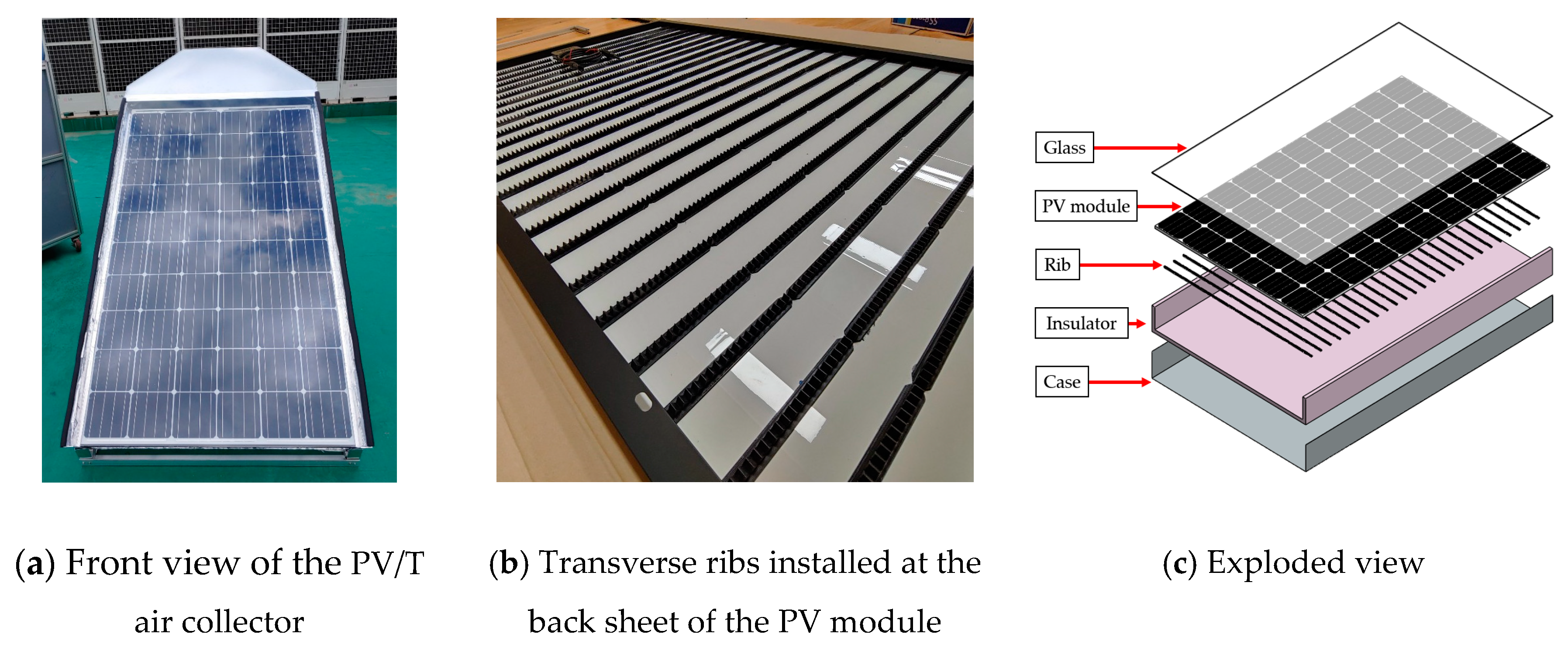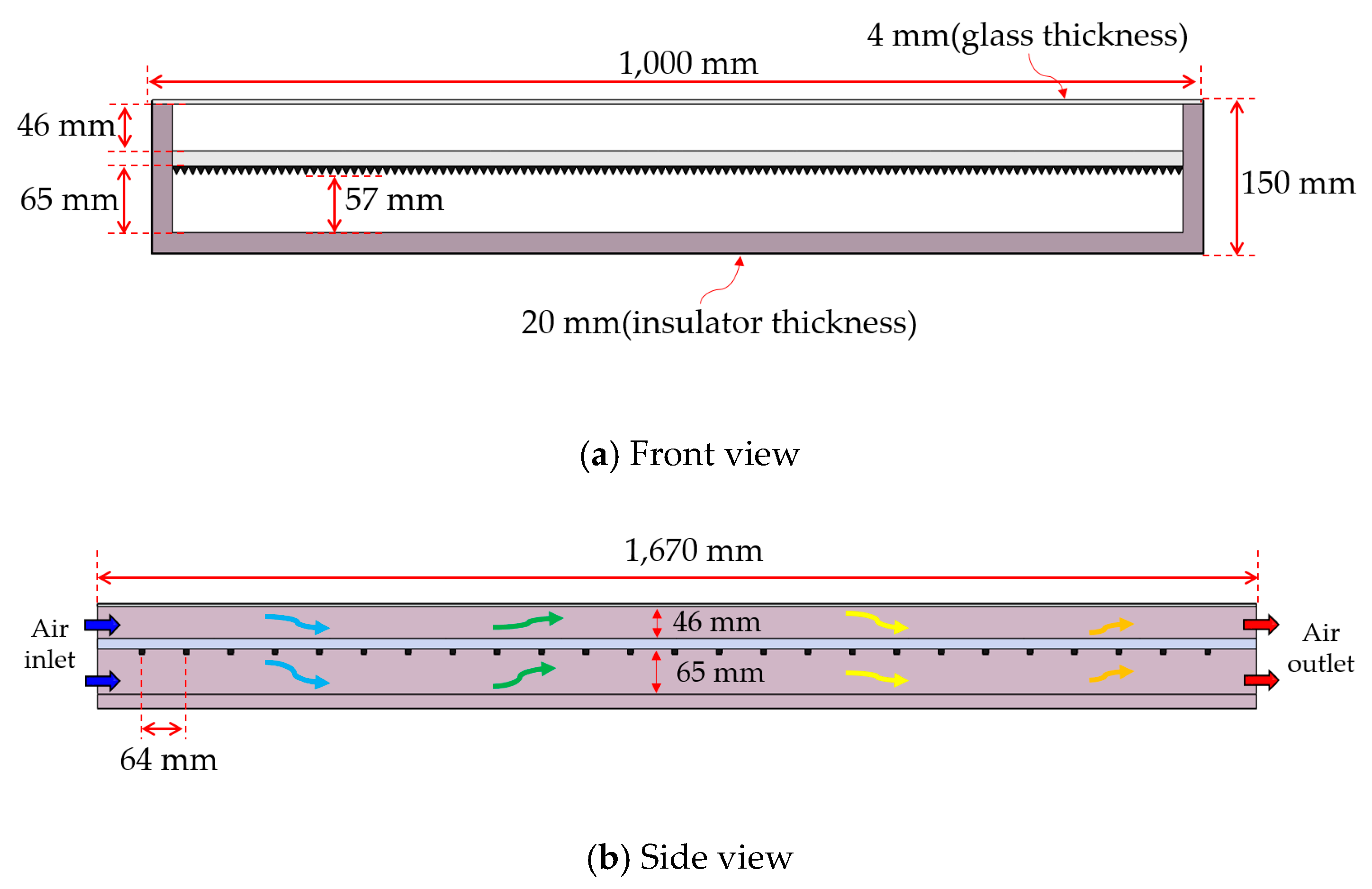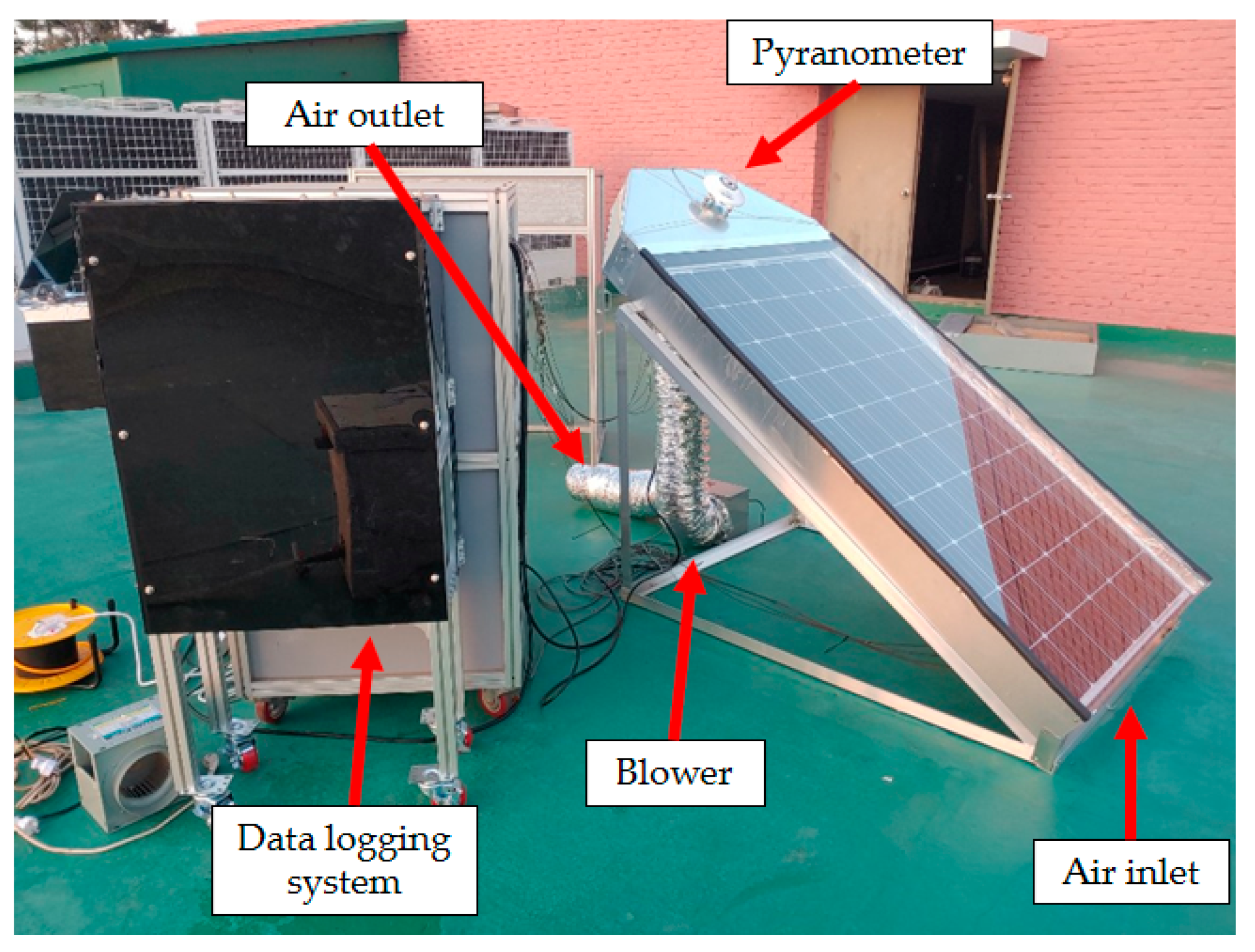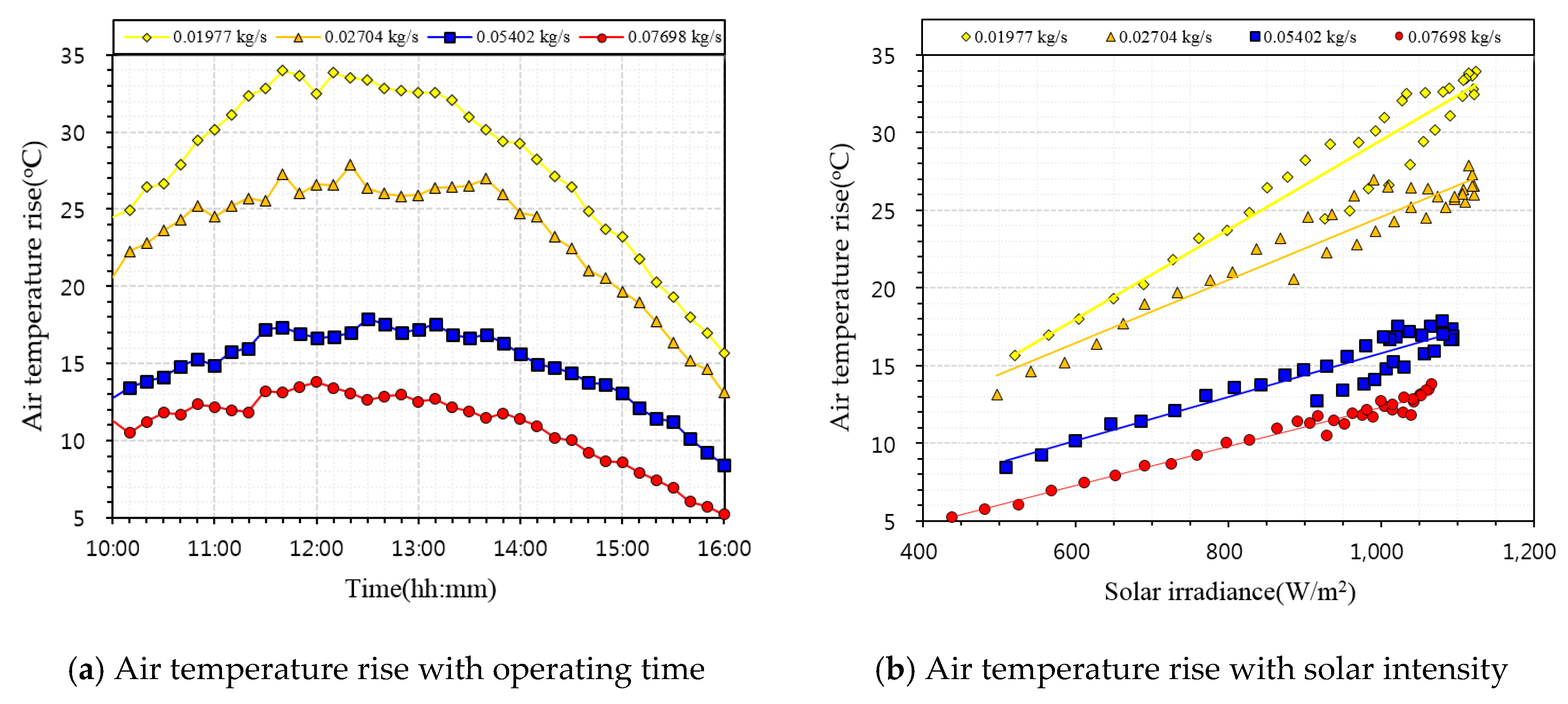Performance Evaluation of PV/T Air Collector Having a Single-Pass Double-Flow Air Channel and Non-Uniform Cross-Section Transverse Rib
Abstract
1. Introduction
2. Experimental Apparatus and Methods
2.1. Description of PV/T Air Collector
2.2. Experimental Setup and Methods
2.3. Performance Evaluation
3. Results and Discussion
3.1. Weather Conditions
3.2. Thermal Performance
3.3. Electrical Performance
3.4. Overall Efficiency
4. Conclusions
Author Contributions
Funding
Acknowledgments
Conflicts of Interest
Nomenclature
| q | Heat transfer rate per unit area of PV/T air collector (W/m2) |
| Air mass flow rate (kg/s) | |
| Specific heat (J/kg K) | |
| T | Temperature (K) |
| G | Solar intensity (W/m2) |
| A | Area (m2) |
| Power (W) | |
| V | Voltage (V) |
| I | Ampere (A) |
| Subscript | |
| air | Air |
| in | Inlet |
| out | Outlet |
| c | Collector |
| PV | Photovoltaic module |
| th | Thermal |
| e | Electrical |
| cell | PV cell |
| overall | Overall |
| Greek Letters | |
| Efficiency (-) | |
| Coverage factor (-) | |
References
- Wolf, M. Performance analyses of combined heating and photovoltaic power systems for residences. Energy Convers. Manag. 1976, 16, 79–90. [Google Scholar] [CrossRef]
- Nualboonrueng, T.; Tuenpusa, P.; Ueda, Y.; Akisawa, A. Field Experiments of PV-Thermal Collectors for Residential Application in Bangkok. Energies 2012, 5, 1229–1244. [Google Scholar] [CrossRef]
- Jahromi, S.N.; Vadiee, A.; Yaghoubi, M. Exergy and Economic Evaluation of a Commercially Available PV/T Collector for Different Climates in Iran. Energy Procedia 2015, 75, 444–456. [Google Scholar] [CrossRef]
- Rosa-Clot, M.; Rosa-Clot, P.; Tina, G.M.; Ventura, C. Experimental photovoltaic-thermal Power Plants based on TESPI panel. Sol. Energy 2016, 133, 305–314. [Google Scholar] [CrossRef]
- Calise, F.; Figaj, R.D.; Vanoli, L. Experimental and Numerical Analyses of a Flat Plate Photovoltaic/Thermal Solar Collector. Energies 2017, 10, 491. [Google Scholar] [CrossRef]
- Lee, J.H.; Hwang, S.G.; Lee, G.H. Efficiency Improvement of a Photovoltaic Thermal (PVT) System Using Nanofluids. Energies 2019, 12, 3063. [Google Scholar] [CrossRef]
- Motamedi, M.; Chung, C.-Y.; Rafeie, M.; Hjerrild, N.; Jiang, F.; Qu, H.; Taylor, R.A. Experimental Testing of Hydrophobic Microchannels, with and without Nanofluids, for Solar PV/T Collectors. Energies 2019, 12, 3036. [Google Scholar] [CrossRef]
- Hussain, M.I.; Kim, J.-H.; Kim, J.-T. Nanofluid-powered dual-fluid photovoltaic/thermal (PV/T) system: Comparative numerical study. Energies 2019, 12, 775. [Google Scholar] [CrossRef]
- Sarafraz, M.M.; Safaei, M.R.; Leon, A.S.; Tlili, I.; Alkanhal, T.A.; Tian, Z.; Goodarzi, M.; Arjomandi, M. Experimental Investigation on Thermal Performance of a PV/T-PCM (Photovoltaic/Thermal) System Cooling with a PCM and Nanofluid. Energies 2019, 12, 2572. [Google Scholar] [CrossRef]
- Liu, X.; Zhou, Y.; Li, C.-Q.; Lin, Y.; Yang, W.; Zhang, G. Optimization of a New Phase Change Material Integrated Photovoltaic/Thermal Panel with The Active Cooling Technique Using Taguchi Method. Energies 2019, 12, 1022. [Google Scholar] [CrossRef]
- Sopian, K.; Yigit, K.S.; Liu, H.T.; Kakaç, S.; Veziroglu, T.N. Performance analysis of photovoltaic thermal air heaters. Energy Convers. Manag. 1996, 37, 1657–1670. [Google Scholar] [CrossRef]
- Othman, M.Y.; Yatim, B.; Sopian, K.; Abu Bakar, M.N. Performance studies on a finned double-pass photovoltaic-thermal (PV/T) solar collector. Desalination 2007, 209, 43–49. [Google Scholar] [CrossRef]
- Vivek, R.; Tiwawri, G.N. A comparison study of energy and exergy performance of a hybrid photovoltaic double-pass and single-pass air collector. Int. J. Energy Res. 2009, 33, 605–617. [Google Scholar] [CrossRef]
- Kumar, R.; Rosen, M.A. Performance evaluation of a double pass PV/T solar air heater with and without fins. Appl. Therm. Eng. 2011, 31, 1402–1410. [Google Scholar] [CrossRef]
- Amori, K.E.; Abd-AlRaheem, M.A. Field study of various air based photovoltaic/thermal hybrid solar collectors. Renew. Energy 2014, 63, 402–414. [Google Scholar] [CrossRef]
- Kim, S.-M.; Kim, J.-H.; Kim, J.-T. Experimental Study on the Thermal and Electrical Characteristics of an Air-Based Photovoltaic Thermal Collector. Energies 2019, 12, 2661. [Google Scholar] [CrossRef]
- Farshchimonfared, M.; Bilbao, J.I.; Sproul, A.B. Channel depth, air mass flow rate and air distribution duct diameter optimization of photovoltaic thermal (PV/T) air collectors linked to residential buildings. Renew. Energy 2015, 76, 27–35. [Google Scholar] [CrossRef]
- Kim, J.-H.; Ahn, J.-G.; Kim, J.-T. Demonstration of the Performance of an Air-Type Photovoltaic Thermal (PVT) System Coupled with a Heat-Recovery Ventilator. Energies 2016, 9, 728. [Google Scholar] [CrossRef]
- Yu, J.-S.; Kim, J.-H.; Kim, J.-T. A Study on the Thermal Performance of Air-Type BIPVT Collectors Applied to Demonstration Building. Energies 2019, 12, 3120. [Google Scholar] [CrossRef]
- Reddy, S.R.; Ebadian, M.A.; Lin, C.X. A review of PV-T systems: Thermal management and efficiency with single phase cooling. Int. J. Heat Mass Transf. 2015, 91, 861–871. [Google Scholar] [CrossRef]
- Al-Waeli, A.H.A.; Sopian, K.; Kazem, H.A.; Chaichan, M.T. Photovoltaic/Thermal (PV/T) systems: Status and future prospects. Renew. Sustain. Energy Rev. 2017, 77, 109–130. [Google Scholar] [CrossRef]












| Parameters | Value |
|---|---|
| Module size (mm) | 1670 × 1000 × 32 |
| Number of cell (ea) | 60 |
| Electrical efficiency at maximum output power (%) | 18.6 |
| Temperature coefficient (%/K) | −0.39 |
| Maximum output power (W) | 310 |
| Output voltage at maximum power (V) | 32.75 |
| Output current at maximum power (A) | 9.46 |
| Parameters | Value | |||
|---|---|---|---|---|
| Date | 16 March 2020 | 21 March 2020 | 18 March 2020 | 23 March 2020 |
| Time | 10:00–16:00 | |||
| Location | Yongdang campus, Pukyong National University, Busan, Korea (35°6.98′ N latitude, 129°5.39′ E longitude) | |||
| Air mass flow rate (kg/s) | 0.01977 | 0.02704 | 0.05402 | 0.07698 |
| Device | Model | Range | Accuracy |
|---|---|---|---|
| Thermocouple | T-type | −281 to 370 °C | 1 °C |
| Pyranometer | MS-802 | 0 to 4000 W/m2 | 2% |
| Hot-wire anemometer | Kanomax 6531-2G | 0.01 to 9.99 m/s | 0.015 m/s |
| Power meter | PW3336-02 | 0 to 1000 V | 0.1% |
| 0 to 50 A | 0.1% | ||
| Multi-function data logger | Agilent 34972A | - | - |
| Time | Air Mass Flow Rate (kg/s) | Time | Air Mass Flow Rate (kg/s) | ||||||
|---|---|---|---|---|---|---|---|---|---|
| 0.01977 | 0.02704 | 0.05402 | 0.07698 | 0.01977 | 0.02704 | 0.05402 | 0.07698 | ||
| 10:00 | 0.3143 | 0.3774 | 0.4534 | 0.5778 | 13:10 | 0.3744 | 0.4048 | 0.5587 | 0.5888 |
| 10:10 | 0.3097 | 0.3899 | 0.4613 | 0.5237 | 13:20 | 0.3713 | 0.4137 | 0.538 | 0.5729 |
| 10:20 | 0.3198 | 0.383 | 0.4605 | 0.5463 | 13:30 | 0.3666 | 0.4275 | 0.5366 | 0.5733 |
| 10:30 | 0.3139 | 0.3874 | 0.4627 | 0.5606 | 13:40 | 0.3613 | 0.4432 | 0.5471 | 0.5661 |
| 10:40 | 0.32 | 0.3888 | 0.4783 | 0.5473 | 13:50 | 0.3599 | 0.4373 | 0.5409 | 0.594 |
| 10:50 | 0.3318 | 0.3946 | 0.4894 | 0.5701 | 14:00 | 0.3731 | 0.4303 | 0.5322 | 0.5927 |
| 11:00 | 0.3352 | 0.3761 | 0.4705 | 0.5553 | 14:10 | 0.3726 | 0.4414 | 0.5247 | 0.5867 |
| 11:10 | 0.3389 | 0.3778 | 0.4857 | 0.5391 | 14:20 | 0.3681 | 0.4347 | 0.5341 | 0.5698 |
| 11:20 | 0.3477 | 0.3815 | 0.4853 | 0.5267 | 14:30 | 0.3703 | 0.437 | 0.5358 | 0.5818 |
| 11:30 | 0.3486 | 0.374 | 0.5152 | 0.5805 | 14:40 | 0.3576 | 0.4249 | 0.5322 | 0.5628 |
| 11:40 | 0.3596 | 0.3968 | 0.5169 | 0.578 | 14:50 | 0.3531 | 0.4304 | 0.548 | 0.555 |
| 11:50 | 0.3581 | 0.3773 | 0.5031 | 0.5872 | 15:00 | 0.3625 | 0.4366 | 0.5521 | 0.5747 |
| 12:00 | 0.3446 | 0.3854 | 0.4961 | 0.5991 | 15:10 | 0.3562 | 0.4464 | 0.541 | 0.5624 |
| 12:10 | 0.3612 | 0.3861 | 0.499 | 0.5868 | 15:20 | 0.3498 | 0.4352 | 0.5413 | 0.564 |
| 12:20 | 0.3583 | 0.4066 | 0.5123 | 0.5758 | 15:30 | 0.3536 | 0.4246 | 0.5667 | 0.5649 |
| 12:30 | 0.3586 | 0.3869 | 0.539 | 0.5611 | 15:40 | 0.3537 | 0.4216 | 0.5518 | 0.5333 |
| 12:40 | 0.3589 | 0.3827 | 0.5364 | 0.572 | 15:50 | 0.3581 | 0.4389 | 0.5425 | 0.552 |
| 12:50 | 0.3595 | 0.3835 | 0.5245 | 0.583 | 16:00 | 0.3583 | 0.4297 | 0.5398 | 0.5516 |
| 13:00 | 0.3664 | 0.3924 | 0.5406 | 0.5706 | |||||
| Time | Air Mass Flow Rate (kg/s) | Time | Air Mass Flow Rate (kg/s) | ||||||
|---|---|---|---|---|---|---|---|---|---|
| 0.01977 | 0.02704 | 0.05402 | 0.07698 | 0.01977 | 0.02704 | 0.05402 | 0.07698 | ||
| 10:00 | 0.1537 | 0.1611 | 0.156 | 0.1623 | 13:10 | 0.1447 | 0.1392 | 0.1493 | 0.1455 |
| 10:10 | 0.1527 | 0.1604 | 0.1549 | 0.1627 | 13:20 | 0.1448 | 0.1376 | 0.1501 | 0.1453 |
| 10:20 | 0.1521 | 0.1583 | 0.1535 | 0.1613 | 13:30 | 0.1455 | 0.1387 | 0.1502 | 0.1452 |
| 10:30 | 0.1506 | 0.1565 | 0.1528 | 0.1598 | 13:40 | 0.1457 | 0.1382 | 0.1503 | 0.1466 |
| 10:40 | 0.1486 | 0.1543 | 0.1518 | 0.1578 | 13:50 | 0.1467 | 0.1364 | 0.1511 | 0.1481 |
| 10:50 | 0.1478 | 0.1529 | 0.1507 | 0.1576 | 14:00 | 0.1477 | 0.1376 | 0.1518 | 0.1495 |
| 11:00 | 0.1464 | 0.1484 | 0.1504 | 0.1571 | 14:10 | 0.1481 | 0.1398 | 0.1522 | 0.1445 |
| 11:10 | 0.1448 | 0.1474 | 0.1489 | 0.1562 | 14:20 | 0.1482 | 0.1420 | 0.1516 | 0.1442 |
| 11:20 | 0.1439 | 0.1464 | 0.1479 | 0.1552 | 14:30 | 0.1476 | 0.1448 | 0.1467 | 0.1426 |
| 11:30 | 0.1429 | 0.1460 | 0.1435 | 0.1545 | 14:40 | 0.1424 | 0.1489 | 0.1494 | 0.1416 |
| 11:40 | 0.1414 | 0.1448 | 0.1467 | 0.1545 | 14:50 | 0.1447 | 0.1513 | 0.1476 | 0.1457 |
| 11:50 | 0.1411 | 0.1431 | 0.1467 | 0.1543 | 15:00 | 0.1416 | 0.1503 | 0.1454 | 0.1445 |
| 12:00 | 0.1413 | 0.1424 | 0.1463 | 0.1539 | 15:10 | 0.1393 | 0.1433 | 0.1425 | 0.1467 |
| 12:10 | 0.1423 | 0.1408 | 0.1463 | 0.1529 | 15:20 | 0.1358 | 0.1399 | 0.1385 | 0.1424 |
| 12:20 | 0.1419 | 0.1387 | 0.1466 | 0.1523 | 15:30 | 0.1301 | 0.1375 | 0.1314 | 0.1375 |
| 12:30 | 0.142 | 0.1400 | 0.1452 | 0.1508 | 15:40 | 0.1239 | 0.1332 | 0.1275 | 0.1299 |
| 12:40 | 0.1428 | 0.1394 | 0.147 | 0.1492 | 15:50 | 0.1159 | 0.1239 | 0.1204 | 0.1222 |
| 12:50 | 0.1431 | 0.1390 | 0.1479 | 0.1471 | 16:00 | 0.1105 | 0.1210 | 0.1132 | 0.1132 |
| 13:00 | 0.1439 | 0.1386 | 0.1483 | 0.1458 | |||||
© 2020 by the authors. Licensee MDPI, Basel, Switzerland. This article is an open access article distributed under the terms and conditions of the Creative Commons Attribution (CC BY) license (http://creativecommons.org/licenses/by/4.0/).
Share and Cite
Choi, H.-U.; Choi, K.-H. Performance Evaluation of PV/T Air Collector Having a Single-Pass Double-Flow Air Channel and Non-Uniform Cross-Section Transverse Rib. Energies 2020, 13, 2203. https://doi.org/10.3390/en13092203
Choi H-U, Choi K-H. Performance Evaluation of PV/T Air Collector Having a Single-Pass Double-Flow Air Channel and Non-Uniform Cross-Section Transverse Rib. Energies. 2020; 13(9):2203. https://doi.org/10.3390/en13092203
Chicago/Turabian StyleChoi, Hwi-Ung, and Kwang-Hwan Choi. 2020. "Performance Evaluation of PV/T Air Collector Having a Single-Pass Double-Flow Air Channel and Non-Uniform Cross-Section Transverse Rib" Energies 13, no. 9: 2203. https://doi.org/10.3390/en13092203
APA StyleChoi, H.-U., & Choi, K.-H. (2020). Performance Evaluation of PV/T Air Collector Having a Single-Pass Double-Flow Air Channel and Non-Uniform Cross-Section Transverse Rib. Energies, 13(9), 2203. https://doi.org/10.3390/en13092203





